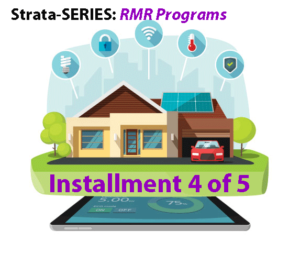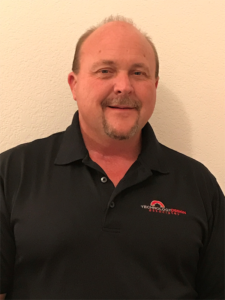[NOTE: This post is part of a series of articles on recurring monthly revenue programs we call Strata-SERIES: RMR Programs. It will likely make more sense to you if you start by reading our Series Introduction here… and then our Topic Introduction and First Installment here…]
 In our last installment, we learned how Ben Lentz and the team at Cyber Technology Group launched an RMR program designed to help their clients understand that sophisticated technology systems require regular maintenance – just like their cars, their pools, and their landscaping. By getting clients on their Client Care Program, which includes regular “wellness visits,” Cyber Tech saw their upgrade sales increase during these visits.
In our last installment, we learned how Ben Lentz and the team at Cyber Technology Group launched an RMR program designed to help their clients understand that sophisticated technology systems require regular maintenance – just like their cars, their pools, and their landscaping. By getting clients on their Client Care Program, which includes regular “wellness visits,” Cyber Tech saw their upgrade sales increase during these visits.
Like Cyber Tech, Ron Wanless of Technology Design Associates (locations in Washington and Oregon) had a slightly different motive for pursuing a recurring monthly revenue program. Little did he know that it was a pursuit that would result in fundamental changes in how they service their clients and run their business.
See how Technology Design Assocs. RMR program cut service costs…
Ron Wanless said he was drawn to establishing some form of a maintenance agreement program (ultimately called the Client Care Program) for Technology Design Associates clients not so much because of the RMR revenue stream, but rather to offer a more proactive program to reduce truck rolls. The traditional model of offering free service on installations meant he lost money on his service operations every time he rolled a truck.
“My company is extremely service oriented and for me, it was not the RMR side that brought me to the table,” Wanless said. “It was actually the ability to limit my truck rolls to a client’s house. Despite the fact that I like the effect of billing my clients for stuff, the objective is – truck roll service calls typically lose money, you spend more than you can bill for.”
Remote Monitoring and Maintenance Solves 82% of Service Calls

Technology Design Assocs.
Wanless instantly saw the value of remote monitoring, which he learned about during a presentation from Ihiji. “I was all over it because I could see the value in logging in and remotely diagnosing the problem immediately, versus sending a truck out to the location,” Wanless said.
And on that point, Wanless noted they’ve been way more successful than he could have ever imagined. “We have gotten good enough with our program now that we actually do 82% of our client’s phone-in service calls remotely, without rolling a truck,” Wanless said proudly. “That a real number.”
‘…Threatened to Slit My Wrists Two or Three Times’
Developing their maintenance agreement program was exceedingly challenging and Wanless said he went through seven or eight iterations before landing on the current version about ten months ago.
“Oh my god, I think I probably threatened to slit my wrists two or three times creating this program,” Wanless laughed. “It was a very difficult process in figuring out primarily what you can get away with to bill a client on a monthly service plan – and what services the client would expect. We have done all kinds of variations of providing services and not providing services, and monitoring and not monitoring – all kinds of other different variations before we found that our current program really works and clients are happy, even if they get billed for something at some point in time.”
Inclusionary Services ‘…Were Not a Hard and Fast Requirement’

The breakthrough came when they realized that inclusionary services were not a hard and fast requirement, and with that realization, the door opened to a “pricing structure low enough that people would buy-in,” but still high enough “that we could cover all of our costs.”
Still, as all of our integrator panel experienced, even at that rate Technology Design Associates experienced some client push-back. Making the leap from no program, or generous free service policy, to one where the client commits to a monthly fee, is almost always a steep hill to climb. The key to getting over the crest, according to Wanless, was to force-feed it.
Had to Force-Feed It
“The way that we got initial buy-in on this whole program was that we force fed it,” Wanless said. “So every client during that two-year period that we sold a system to was required to be on the program for a year.”
It was not easy, and Wanless admits that they lost a couple of projects because of that requirement. “But we stood firm with it and we made it happen,” Wanless said. “And I have yet to have anybody who still has the system that we installed that we force fed that program to that has dropped off after that first year – they’ve all renewed.”
After-Hours Hotline
Like the others, their Client Care Program provides an after-hours hotline, staffed by one of their top technicians. Techs are assigned on a rotating schedule to take the after-hours calls for one week at a time. The company pays the tech a flat fee by engagement and, as noted, usually is able to solve the problem remotely. If a truck roll is required, then it is scheduled for the next day.
And as others on our panel have reported, Wanless says they often go for weeks without any after-hours calls.
Wanless said the Client Care Program is very important for Technology Design Associates’ business. First, he notes that this program has set them apart from competitors, many of whom offer no support programs for clients whatsoever. Second, the concept of proactive service “has made a huge change in our culture and in how our team looks at” installs and post installation servicing.
More Subscriptions Means More Company Value
Finally, Wanless notes that as they continue to grow their base of customers subscribing to the Client Care Program, the value of his company rises. Several on our panel mentioned how a robust RMR program can increase the value of the company when it is time for the owner to look at an exit.
“Financially, we’re at a point now where we have enough people into it [the Client Care Program] that it pays for itself and by the end of the year it will generate a bottom line profit for us in that portion of our business,” Wanless said. “In the long run, it will establish a good solid income, as well as be a great selling point for the company.”
See more on Technology Design Associates by visiting: techdesignassociates.com.
NEXT WEEK> Matt Walin of Brilliant AV struggles with RMR, until he discovers a new solution.
BE SURE TO SEE Other Installments in Strata-SERIES: RMR Programs
Series Introduction: Not Just Revenue – A Redefined Client Relationship
First Installment: Just What Kind of Business Are You In?




Leave a Reply